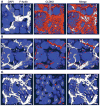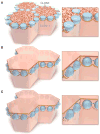Germ cell migration across Sertoli cell tight junctions
- PMID: 22997133
- PMCID: PMC3694388
- DOI: 10.1126/science.1219969
Germ cell migration across Sertoli cell tight junctions
Abstract
The blood-testis barrier includes strands of tight junctions between somatic Sertoli cells that restricts solutes from crossing the paracellular space, creating a microenvironment within seminiferous tubules and providing immune privilege to meiotic and postmeiotic cells. Large cysts of germ cells transit the Sertoli cell tight junctions (SCTJs) without compromising their integrity. We used confocal microscopy to visualize SCTJ components during germ cell cyst migration across the SCTJs. Cysts become enclosed within a network of transient compartments fully bounded by old and new tight junctions. Dissolution of the old tight junctions releases the germ cells into the adluminal compartment, thus completing transit across the blood-testis barrier. Claudin 3, a tight junction protein, is transiently incorporated into new tight junctions and then replaced by claudin 11.
Figures




References
-
- Tsukita S, Furuse M, Itoh M. Multifunctional strands in tight junctions. Nat Rev Mol Cell Biol. 2001 Apr;2:285. - PubMed
-
- Schneeberger EE, Lynch RD. The tight junction: a multifunctional complex. Am J Physiol Cell Physiol. 2004 Jun;286:C1213. - PubMed
-
- Tsukita S, Yamazaki Y, Katsuno T, Tamura A. Tight junction-based epithelial microenvironment and cell proliferation. Oncogene. 2008 Nov 24;27:6930. - PubMed
-
- Dym M, Cavicchia JC. Further observations on the blood-testis barrier in monkeys. Biol Reprod. 1977 Oct;17:390. - PubMed
-
- Weber JE, Russell LD. A study of intercellular bridges during spermatogenesis in the rat. Am J Anat. 1987 Sep;180:1. - PubMed
Publication types
MeSH terms
Substances
Grants and funding
LinkOut - more resources
Full Text Sources
Molecular Biology Databases

